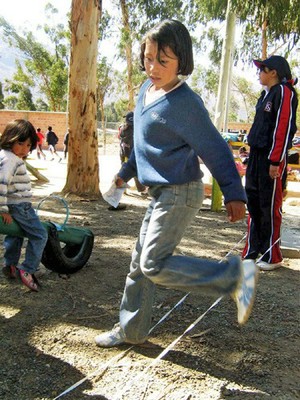Child Sponsorship background from La Paz, Bolivia
 SOS Children's Village Mallasa, near La Paz
SOS Children's Village Mallasa, near La Paz
The SOS Children's Village Mallasa, situated in La Paz, was completed in 1983. La Paz is located in the Bolivian highlands at an altitude of 3,600 metres above sea level at the foot of the Illimani, Bolivia's highest mountain (6,882 metres). The SOS Children's Village is situated in a southern suburb of the capital Mallasa, about 20 minutes from the city centre by car. Although Mallasa is part of La Paz, it still has rural characteristics.
The SOS Children's Village consists of twelve family houses for up to 108 children, the village director's house, an administrative building and an SOS aunts’ house (SOS Children's Village mothers in training, who assist current SOS mothers in their everyday work, and stand in for them if they are ill or on holiday). Another two SOS families are housed in rented flats outside the SOS Children's Village.
Other SOS Projects in Mallasa
An SOS Primary School and an SOS Nursery, in which the Montessori Method is applied, are also part of the infrastructure of the SOS Children's Village Mallasa. The school, which opened in 1986, has a capacity of up to 450 pupils from the SOS Children's Village, as well as from the neighbourhood. The school consists of 16 classrooms, a seminar room, a library, a pottery, two sports grounds, an administrative unit and a small health care centre in which a paediatrician and a dentist work.
Two SOS Vocational Training Centres lie close to the Children's Village. The "Centro de Formación Técnica SOS CENFOTEC Mallasa" opened in 1988, and provides up to 50 trainees from the children's village with a choice of graphics and design, joinery, printing, tailoring, electrical training and mechanics.
The "Centro de Formación Profesional CENFOPRO Mallasa" is especially designed to support and train girls, and has (since early 2002) offered training on office work with a focus on IT to up to 170 children.
Four SOS Youth Homes for girls and four SOS Youth Homes for boys were created in the town of La Paz, where up to 95 adolescents are housed in shared flats throughout their secondary or vocational education in order to gradually prepare them for an independent life.
Background to La Paz
La Paz is the administrative capital of Bolivia, as well as the departmental capital of La Paz Department, and the second largest city (in population) after Santa Cruz de la Sierra.

 Return to Schools Wikipedia Home page…
Return to Schools Wikipedia Home page…
